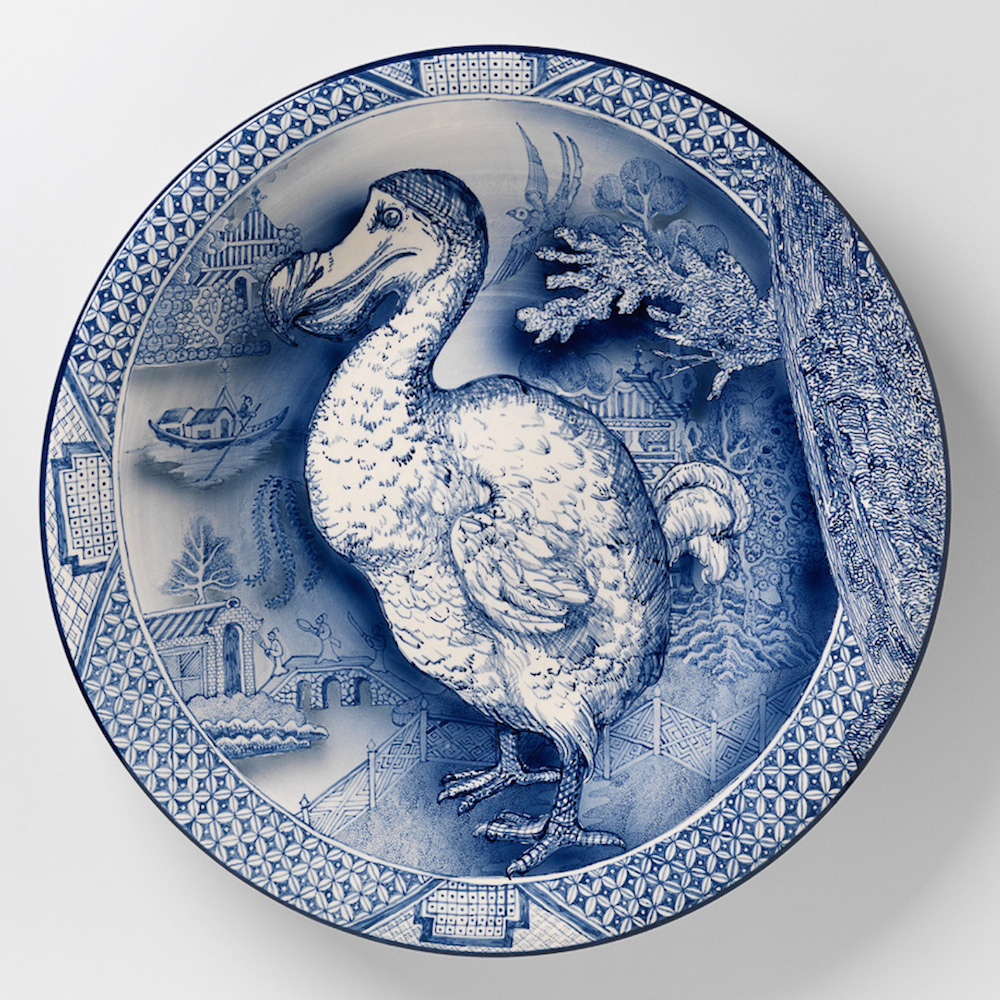We occasionally like to exult in the breadth and diversity of contemporary ceramics and contemporary ceramic art, hence: Spotted, our weekly roundup of different objects and exhibitions that have demanded our attention. We’re starting off this week with work from the studio of Stephen Bowers!
Stephen Bowers: Jamais Vu (Victoria, Australia, November 12 — December 10) recently wrapped up at Lauraine Diggins Fine Art Gallery. The artist defines Jamais Vu as “the feeling that one has never seen before something that should be quite familiar when one looks at something familiar, like a common word, it strangely seems meaningless or unrecognized.” The gallery states of the exhibition:
Above image: Stephen Bowers, In the Land of the Dodo, 2013; wheel thrown earthenware, underglaze color, clear glaze, 7 x 61 cm
Following the success of his Australia-wide touring exhibition (2013-2015) and growing international recognition, Bowers continues to celebrate and provoke with his beautifully detailed decorated ceramics. Drawing inspiration from a variety of sources, his work explores natural history and art history, particularly of ceramics. Further, his work draws on decorative arts historical references and is imbued with his own personal commentary and witticisms.
The focus of the exhibition will be a remarkable Camouflage Series dining setting featuring richly adorned serving, dinner and entrée plates, each displaying an Australian parrot, highlighted against a complex layering of background patterns, binding these ambitious works together as a set.

Stephen Bowers, Pair of Staffordshire Dogs, 2013; hand-built, one-off, artist’s proof pair, earthenware, underglaze color, clear glaze, on-glaze burnished gold and enamels, 75 x 43 cm. Click to see a larger image.

Stephen Bowers, Exotic Birds and Strange Fruit, Pair of Large Mirrored Palaceware Vases, 2012; wheel-thrown earthenware, underglaze color, clear earthenware glaze and on-glaze gold luster, 74 x 55 cm
David Steumpfle Curates North Carolina Pottery Exhibit
From the Mint Museum in Charlotte, North Carolina:
On the occasion of the 12th Annual Mint Museum Potters Market Invitational presented by the Delhom Service League, the museum invited North Carolina potter David Stuempfle (b.1960) to create an installation in the Mint’s gallery devoted to North Carolina pottery. The museum tasked Stuempfle to use objects by artists whose work is featured in Potters Market Invitational 2016 and represented in the Mint’s permanent collection. Stuempfle decided to present these pots in a global context to emphasize that North Carolina’s potters draw from other pottery traditions across time and space. He began by searching the museum’s database and storage rooms to find other North Carolina ceramics as well as clay work from around the globe that appealed to him on an aesthetic level. The artist ended up with a striking selection of objects from our state paired with ceramics from ancient America, Asia, and Africa. Stuempfle stated: “There’s a universal quality to great pots and I wanted to show the similarity. Instead of segregating these pots based on cultural geographies, we chose to bring these pots together to show that universality.” Some of the pots were chosen because they are related to North Carolina ceramics, others because they were the best representation of the Mint’s collection, and still others for certain specific details, such as a beautiful Tenmoku glaze (an iron-rich black glaze with rust highlights) or the markings from a firing process. “I see things from the potter’s perspective—as someone involved in materials and the making process.”
Peter Shire: A Survey of Ceramics: 1970s to the Present, New York
Peter Shire: A Survey of Ceramics: 1970s to the Present (New York, September 8 – October 9, 2016) recently wrapped up at the Derek Eller Gallery. The show was a career-spanning exhibition for the “playful and garish” third wave Modernist. The gallery states of the exhibition:
Peter Shire has lived in Los Angeles and worked in ceramic for all of his life. The immediacy of clay has provided an outlet for an aesthetic built from particularly Californian influences as disparate and exuberant as hot rod culture (the mechanic Bob Hayes was a childhood neighbor) and Ken Price’s 1969 solo exhibition at Mizuno Gallery which Shire visited in his youth. Along with Price, Post-Pottery artists such as Ron Nagle, John Mason and Peter Volkous helped shape his euphoric, absurd and irreverent relationship to functionality and informed his pluralistic approach to producing art.
While his work borrows from Futurist and Bauhaus design (notably Marianne Brandt’s seminal silver teapot), the aura of the work is playfully rooted in the garish second and third iterations of Modernism. He recalls frequently passing John Lautner’s Googie coffee shop on Sunset Boulevard on his way to the beach as a child. This Mid-Century modern storefront with a large, protruding, striped fin embodied what Shire describes as the “California high kitsch” aesthetic, a particular brand of kitsch imitating modernism. That a conventional design (in this instance a roadside cafe) could be radicalized by such ecstatic and boisterous additive process has had a lasting effect on Shire’s vision.
Do you love or loathe these works of contemporary ceramics and contemporary ceramic art? Let us know in the comments.














Add your valued opinion to this post.